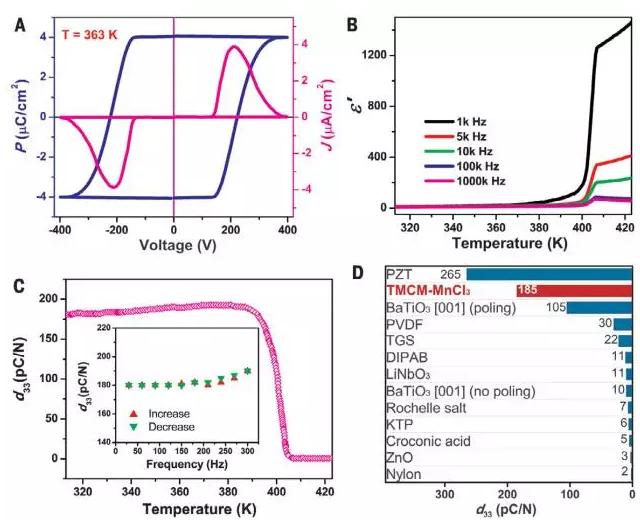Research Progress of Organic Inorganic Perovskite Molecular Piezoelectric Materials

Figure 1 Ferroelectric, Dielectric and Piezoelectric Properties of Trimethylchloromethylammonium Manganate(II) Chloride

Figure 2 Ferrocene domain structure, piezoelectric response, and multipole properties of trimethylchloromethylammonium manganese(II) chloride salt
Recently, the Shenzhen Institute of Advanced Technology of the Chinese Academy of Sciences in cooperation with professors Xiong Rengen and You Yumeng of the Southeast University and the University of Toledo, Nanjing University, and Peking University in the United States have made breakthroughs in organic-inorganic perovskite molecular piezoelectric materials. Related research work was published in Science on July 21. Southeast University is the first communication unit, the United States Toledo University, Shenzhen Institute of advanced nanometer control and biomechanics research unit for the common communication unit, Southeast University professor You Yumeng, Dr. Liao Weiqiang and other co-first author, Xiong Rengen as the first correspondence author.
For nearly a century, ferroelectric materials have played an indispensable role in information storage and other fields, and their excellent piezoelectric properties have also attracted wide attention. With the development of ferroelectric research, ferroelectrics composed of inorganic ceramics dominate the research. As representative of inorganic ceramic ferroelectrics, barium titanate (BTO) has high spontaneous polarization (26 μC/cm2), high Curie temperature (393K) and large piezoelectric coefficient (190pC/N), and is widely used Acoustic systems, ultrasonic transducers, surface acoustic wave electronics, high-strain actuators, high-energy storage density systems, microelectronics machining, and other fields have become important functional materials for all levels of modern society. In spite of this, the disadvantages of the high cost of inorganic ceramic ferroelectric film formation, the need for high-temperature sintering, and the presence of potentially toxic elements are gradually exposed. In contrast, molecular ferroelectrics combine the advantages of lightweight, flexibility, flexible structure, easy film formation, total liquid phase synthesis, and environmental protection and energy saving, and are more adaptable to new generation thin film devices, microelectronic mechanical systems and wearable devices. Development needs.
In order to promote the practical application of molecular ferroelectric materials, many scientists from home and abroad are committed to obtaining new molecular ferroelectrics with excellent performance. Combining years of experience in optimization of ferroelectric properties and exploration of the piezoelectric properties of molecular material systems, Jiangsu Key Laboratory of Molecular Ferroelectric Science and Applications, University of Toledo, Shenzhen Advanced Institute, Peking University, Researchers at Nanjing University conducted joint efforts and finally obtained two cases of organic-inorganic perovskite-type multipole molecular ferroelectrics with a high Curie temperature (>400 K): trimethylchloromethyl ammonium ammonium chlorate ( II) Salts (TMCM-MnCl3) and Trimethylchloromethylammonium Cdrate (TMCM-CdCl3). Due to their special full ferroelectric-hemi-ferroelastic properties, special polarization rotations can occur under stress, resulting in piezoelectric coefficients (d33) of up to 185 pC/N and 220 pC/N. The d33 of these two molecules is not only more than all previous molecular materials, but also close to or even beyond the BTO. In addition to the ferroelectric and piezoelectric properties of the bulk material, the team also calibrated the six polar axes of the material on a micrometer scale using a piezoelectric microscope. At the same time, a thin film sample with a thickness of micrometer was prepared by a simple solution method. , And successfully observed ferroelectric flipping and piezoelectric effects. This original research achievement has broken the monopoly position of traditional inorganic metal oxides in the piezoelectric field, and opened up a new road for the application of molecular materials in mechanical-electrical conversion, ultrasonic transducer, acoustic detection, and acoustic detection. .
The research was supported by the National Science and Technology Ministry's 973 project, the national key research and development program of nanotechnology key projects, and the National Natural Science Foundation of China's major research plan and major instrument development program.
Direct Dyes,Eco Friendly Dyestuff,Fabric Dye,Basic Dyes
ZHEJIANG E-DYE SUPPLY CHAIN MANAGEMENT CO.,LTD. , https://www.easytodyes.com
